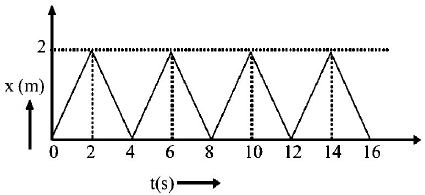Question
The force $$F$$ acting on a particle of mass $$m$$ is indicated by the force-time graph shown below. The change in momentum of the particle over the time interval from $$0$$ to $$8 s$$ is
The force $$F$$ acting on a particle of mass $$m$$ is indicated by the force-time graph shown below. The change in momentum of the particle over the time interval from $$0$$ to $$8 s$$ is

A.
$$24\,N{\text{-}}s$$
B.
$$20\,N{\text{-}}s$$
C.
$$12\,N{\text{-}}s$$
D.
$$6\,N{\text{-}}s$$
Answer :
$$12\,N{\text{-}}s$$
Solution :
The area under $$F$$-$$t$$ graph gives change in momentum.
For 0 to $$2s,$$ $$\Delta {p_1} = \frac{1}{2} \times 2 \times 6$$
$$ = 6\,kg{\text{-}}m/s$$
For 2 to $$4s,$$ $$\Delta {p_2} = 2 \times - 3 = - 6\,kg{\text{-}}m/s$$
For 4 to $$8s,$$ $$\Delta {p_3} = 4 \times 3 = 12\,kg{\text{-}}m/s$$
So, total change in momentum for 0 to $$8s$$
$$\eqalign{ & \Delta {p_{{\text{net}}}} = \Delta {p_1} + \Delta {p_2} + \Delta {p_3} \cr & = \left( { + 6 - 6 + 12} \right) \cr & = 12\,kg{\text{-}}m/s \cr & = 12\,N{\text{-}}s \cr} $$
NOTE
Graphs on negative axis gives - ve momentum.
The area under $$F$$-$$t$$ graph gives change in momentum.
For 0 to $$2s,$$ $$\Delta {p_1} = \frac{1}{2} \times 2 \times 6$$
$$ = 6\,kg{\text{-}}m/s$$
For 2 to $$4s,$$ $$\Delta {p_2} = 2 \times - 3 = - 6\,kg{\text{-}}m/s$$
For 4 to $$8s,$$ $$\Delta {p_3} = 4 \times 3 = 12\,kg{\text{-}}m/s$$
So, total change in momentum for 0 to $$8s$$
$$\eqalign{ & \Delta {p_{{\text{net}}}} = \Delta {p_1} + \Delta {p_2} + \Delta {p_3} \cr & = \left( { + 6 - 6 + 12} \right) \cr & = 12\,kg{\text{-}}m/s \cr & = 12\,N{\text{-}}s \cr} $$
NOTE
Graphs on negative axis gives - ve momentum.

